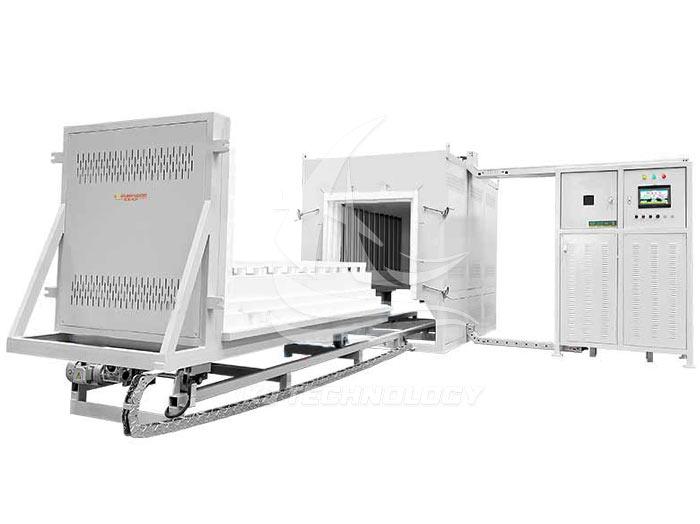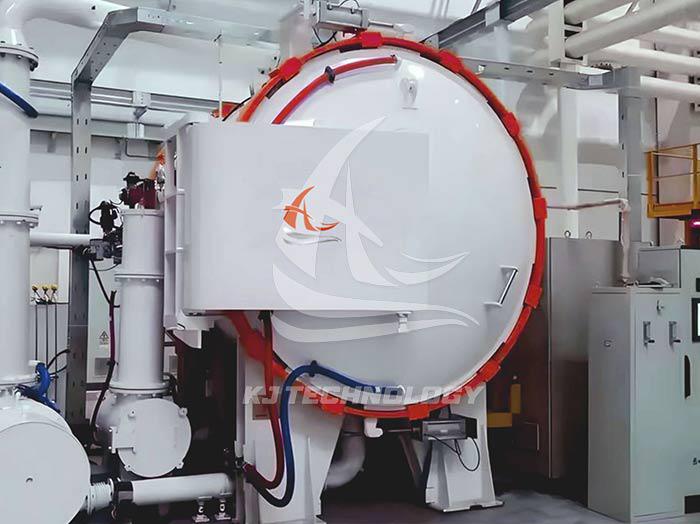High fidelity air quenching furnace application field
 11-18-2025 Author: KJ technology
11-18-2025 Author: KJ technology
Gaozhen air quenching furnace, with its core advantages of high vacuum environment and high-pressure gas quenching, is widely used in high-end manufacturing fields such as aerospace, automotive manufacturing, precision machinery, medical equipment, and energy equipment. The specific application scenarios and advantages are as follows:
1. Aerospace field
Titanium alloy component treatment
Application scenario: Key components such as aircraft engine blades, turbine discs, landing gear, etc. need to have high strength, high temperature resistance, and corrosion resistance.
Technical advantages: High vacuum environment (ultimate vacuum degree ≤ 5 × 10 ⁻ ³ Pa) completely eliminates oxidation, high-pressure gas quenching (nitrogen/argon pressure up to 10-20 bar) achieves rapid and uniform cooling, controls the precipitation morphology of alpha phase, and improves material fatigue life.
Case: After solid solution strengthening treatment, nickel based high-temperature alloys eliminate casting segregation defects and meet the extreme working conditions of aircraft engines.
Manufacturing of high-temperature alloy components
Application scenarios: Rocket engine nozzles, spacecraft thermal protection systems, etc. need to withstand ultra-high temperatures (>1000 ℃) and complex stress environments.
Technical advantages: The maximum working temperature of the equipment reaches 1300 ℃, and the temperature field uniformity is ≤± 5 ° C, ensuring the consistency of material phase transition and avoiding the risk of cracking.
2. Automotive manufacturing field
Precision Gear and Transmission System
Application scenarios: Transmission synchronizer bushings, automatic transmission main reduction sun gear axles, etc. require high dimensional accuracy and wear resistance.
Technical advantages: Graded gas quenching technology (temperature can be set at 180-200 ℃) achieves self tempering through isothermal retention, reduces thermal distortion, and improves the qualification rate.
Case: The French ECM company's dual chamber high-pressure gas quenching furnace processed transmission gears, resulting in a reduction in the average value of tooth profile distortion.
Heat treatment of mold steel
Application scenarios: Die casting molds and injection molds require high hardness and thermal fatigue resistance.
Technical advantage: High pressure nitrogen quenching results in higher hardness of φ 60mm high-speed steel, with significantly better thermal hardening than oil quenching.
3. Precision Machinery and Tool Manufacturing
Processing of tooling steel
Application scenario: Stamping molds and cutting tools require high surface quality and wear resistance.
Technical advantages: Vacuum environment avoids decarburization, high-pressure gas quenching achieves uniform transformation of martensite, and tool life is increased by 2-3 times.
Case: After vacuum high-pressure gas quenching, H13 steel has better anti chipping performance than traditional oil quenching process.
Heat treatment of magnetic materials
Application scenarios: Permanent magnets and soft magnetic alloys require precise control of grain orientation and coercivity.
Technical advantages: High vacuum environment prevents oxidation, gradient cooling process optimizes magnetic domain structure, and enhances material magnetic properties.
4. Medical device field
Precision machining of stainless steel parts
Application scenarios: Surgical instruments and implants (such as hip and knee joints) require biocompatibility and surface smoothness.
Technical advantages: Vacuum solution treatment eliminates stress, and after gas quenching, the surface roughness is lower, meeting medical grade standards.
Case: After vacuum high-pressure gas quenching, the fatigue strength of titanium alloy implants is improved and their biocompatibility is excellent.
5. Energy equipment field
Manufacturing of key components for nuclear power
Application scenario: Nuclear reactor pressure vessels and steam generator heat transfer tubes require radiation resistance and corrosion resistance.
Technical advantages: High vacuum environment avoids hydrogen embrittlement, high-pressure gas quenching controls residual stress, and extends the service life of components.
New energy battery material processing
Application scenarios: Lithium battery electrodes and fuel cell bipolar plates require high conductivity and corrosion resistance.
Technical advantages: Vacuum sintering and gas quenching composite process optimizes the microstructure of materials, improves energy density and cycling stability.








